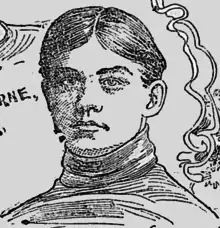Ormond Simkins
Ormond Simkins (May 16, 1879 – December 4, 1921) was an American football and baseball player for the Sewanee Tigers of Sewanee: The University of the South. He was the son of William Stewart Simkins, who may have fired the first shot of the American Civil War.
 Simkins depicted c. 1900 | |
| Sewanee Tigers | |
|---|---|
| Position | Fullback Catcher (baseball) |
| Class | 1902 |
| Personal information | |
| Born: | May 16, 1879 Corsicana, Texas, U.S. |
| Died: | December 4, 1921 (aged 42) Washington, D.C., U.S. |
| Height | 5 ft 10 in (1.78 m) |
| Weight | 163 lb (74 kg) |
| Career history | |
| College | Sewanee (1896–1901) |
| Career highlights and awards | |
| |
Early years
Ormond was born on May 16, 1879, in Corsicana, Texas, to William Stewart Simkins and Elizabeth Ware.
Sewanee
Ormond entered Sewanee in 1896 as a law student.[1] He was valedictorian of the 1900 class.
Baseball
On the baseball team he was the catcher and when captain of the team in 1901, moved to shortstop.[2]
Football
Simkins was an All-Southern[3] fullback and punter of the Sewanee Tigers football team from 1896 to 1901.[4] A stained glass window at Sewanee depicts Simkins handing a football to Henry D. Phillips.[5]
1899
He was a member of the 1899 "Iron Men" of Sewanee that went undefeated and won 5 road games in 6 days all by shutout. Fuzzy Woodruff wrote of the only game in which Sewanee was scored upon, the 11 to 10 win over Auburn, "Under Heisman's tutelage, Auburn played with a marvelous speed and dash that couldn't be gainsaid and which fairly swept Sewanee off its feet. Only the remarkable punting of Simkins kept the game from being a debacle."[6]

In a 1944 interview former coach Billy Suter said of Simkins, "one of the greatest football players I ever saw, a fine kicker, a fine ball carrier, and the most terrific tackler and blocker I ever saw."[6] Simkins is the fullback on the All-Time Sewanee football team,[7] one publication of which notes "Sewanee's greatest backfield ace, Ormond Simkins, unfortunately died some years ago from the effects of a football injury from which he never recovered after leaving college. A wonderful punter and a hard running ball carrier, he deserves much of the credit for Sewanee's wonder team of 1899."[7]
A documentary film about the team and Simkins' role was released in 2022 called "Unrivaled: Sewanee 1899."[8]
Death
Simkins had suffered injuries to both legs while playing football. In later years, his left foot had to be amputated. While working for the War Risk Bureau in Washington, D. C. he entered Georgetown University Hospital in order to have the other one amputated, and died. Henry Seibels would later tell his two sons and an inquiring newsman it was Simkins, not he, who was the best player from Sewanee's 1899 team.[1][6] A field house with his name is part of the Juhan Gym at Sewanee, where the school plays basketball.
References
- Givens, Wendell (1993). "Sewanee's Football Iron Men of 1899". Tennessee Historical Quarterly. Tennessee Historical Commission and the Tennessee Historical Society. 52.
- "Sewanee Has Prospects Of The Championship". Atlanta Constitution. May 6, 1901.
- "All-Southern Eleven for 1900". Outing. Outing Publishing Company. 37: 616. 1901.
- "Sewanee's 1899 Tour Toughest?". Corsicana Daily Sun. October 19, 1961. p. 14. Retrieved April 14, 2015 – via Newspapers.com.

- Sarah Christie (4 November 2014). "Campus Celebrities: 1899 Iron Men".
- Wendell Givens (2003). Ninety-Nine Iron: The Season Sewanee Won Five Games in Six Days. University of Alabama Press. pp. 28–29, 94–95, 119–120. ISBN 9780817350628.
- George Trevor. "All-Time All-Star Team". Tulane University Football Program-The Greenie; Sewanee Vs. Tulane: 6.
- "Unrivaled: Sewanee 1899", Wikipedia, 2023-01-23, retrieved 2023-01-31